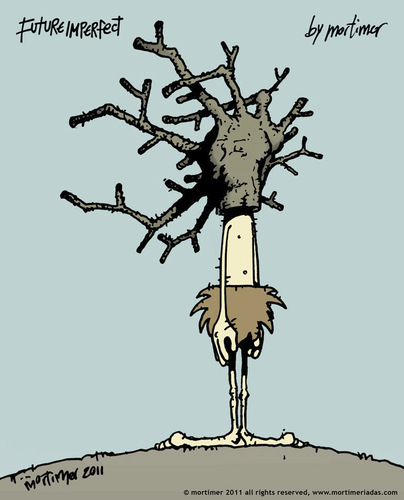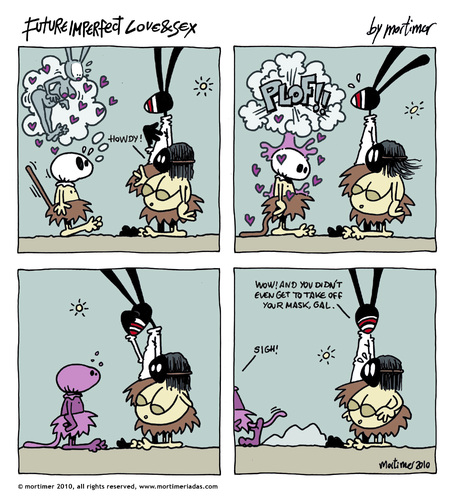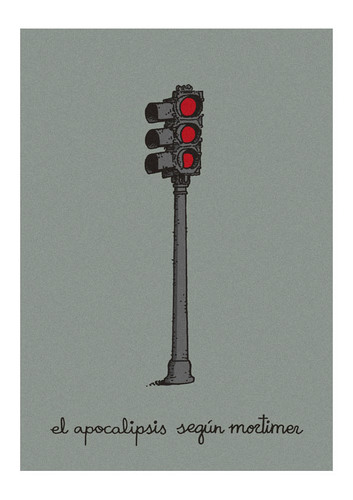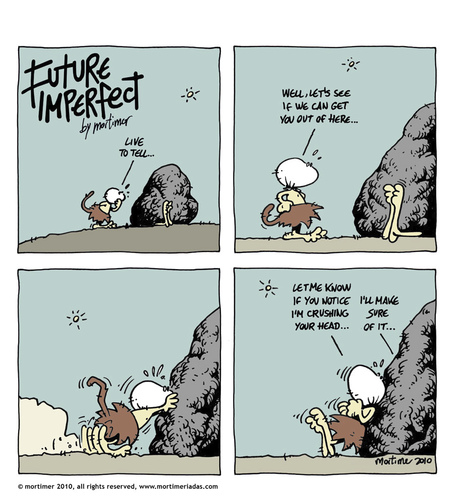
Mortimer is based in Albacete, Spain. His ink drawings and various series of newspaper cartoons have been a part of toonpool.com pretty much from the beginning.
![]() Mortimer, a year ago, I sent out questionnaires to toonpool.com artists in which, among others, I asked about their musical preferences. The part of your answer that stuck with me was “Psychfolk”. I found this strangely fitting with your fantastic, almost psychedelic cartoon settings. Do you see such a connection between your tastes in music and your art?
Mortimer, a year ago, I sent out questionnaires to toonpool.com artists in which, among others, I asked about their musical preferences. The part of your answer that stuck with me was “Psychfolk”. I found this strangely fitting with your fantastic, almost psychedelic cartoon settings. Do you see such a connection between your tastes in music and your art?
Absolutely. Psychfolk is a genre that keeps a balance between an atmospheric sound and a progressive and psychedelic rhythm with tribal overtones. It makes my mind wander around in strange ways, and it makes the creative process more lively and rich in both the development and the final results.
Artistic creation for me is a kind of trance where you have to find the balance between technique and this dark and mysterious side that is out of the creator’s control. So, when you finish a drawing you ask yourself: “Have I really done this?”
Something similar happens in Psychfolk. The juxtaposition of sounds and repetition create structures quite different from the original approach.
 Any Psychfolk recommendations?
Any Psychfolk recommendations?
For the ones interested in listening to this type of music, I’d recommend Davenport’s “Free Country”, or artists like Hala Strana, Ignatz, and Lichens.
How do the themes of this kind of music inform your cartoons?
Although Psychfolk is a very recent musical style, its roots lie in a pagan or shamanic tradition. In a way it is religious music, trance music that looks for a communion of human and nature, the lost spirituality and the awakening of a new conscience. At the same time it’s a type of music “from the future”. It’s the soundtrack of the end of the world or a near future that with no doubt won’t be very different from the time we are living now, or at least I hope so.
In my cartoons and strips from the last few years I have tried to reflect very similar ideas: ecology, anarcho-primitivism, rewilding, shamanism, the psychedelic and the absurd… Comic is a medium very different from music. I didn’t know how far this attitude or concepts could appear in my work, but I suppose that my answers show that they indeed do.
 This seems plausible in particular for your Future Imperfect series. Can you tell a little bit about it?
This seems plausible in particular for your Future Imperfect series. Can you tell a little bit about it?
“Future Imperfect” is a play on words. It is the name of a verbal tense in Spanish, and at the same time a good description of the near future. The characters in Future Imperfect live in one of the multiple possible post-apocalyptic futures.
It’s a very near future where there are still remains of the technological past. The ecosystem has been destroyed by the humans, like in Mad Max. Culture has been erased from earth and human beings live in a state similar to cavemen, a tribal society where superstition and ignorance have replaced any sign of culture.
The characters wear fur and cover their faces with hoods and masks to protect themselves from solar radiation. I originally thought that the hoods were remains from a religion of the end of the world. A religion whose acolytes, ashamed of their human condition decided to hide their face forever, as a penance for the irreparable damage done to Earth.
Maybe at the beginning those masks were gas masks that allowed people to breathe in that filthy atmosphere. But at the end they became part of another absurd tradition, or a fashion. But this is all conjecture.
 So, how was Earth destroyed in Future Imperfect?
So, how was Earth destroyed in Future Imperfect?
I will quote from one of my recent comic-strips from my The End of the World series: “The end of the world arrived more or less when everybody thought it would, and it was a little bit of everything; meteorites, nuclear wars, volcanoes, earthquakes, tsunamis, an alien invasion, a black hole, raptures, zombies, mutants and demons. There were even celestial trumpets, quite a show, it was the least one could expect from that occasion.”
This kind of future sounds very negative – destruction, superstition and ignorance and all. How does this go together with the more positive view of shamanism and anarcho-primitivism you mentioned earlier?
My position is very simple: I am trying to express that the values and creeds of humanity’s remote past – like spirituality and shamanism – must be regained, reinterpreted and adapted to the people of the 21st century.
Still, we can’t and shouldn’t erase the entire history of humankind. We need to learn from our mistakes and correct them. In the course of the centuries humans have committed huge atrocities but they have also created some beautiful things that we must protect for future generations.
If primitivism developed as a result of an actual catastrophe, of the Apocalypse, it wouldn’t develop from free will. We wouldn’t see ourselves as a new and advanced life form but as having taken an irreversible step in a fight for survival. Everything would start all over again and we wouldn’t have learned anything.
 How did you start developing the Future Imperfect world?
How did you start developing the Future Imperfect world?
Like almost all ideas it developed out of nowhere, I guess. Maybe from some long-forgotten sketch in a notepad. I started drawing the series around Winter 2009 and kept working on the story for two years until it finally took shape. I think that’s pretty typical for comic strips.
I have always been a big fan of Science Fiction. Future Imperfect was a good way to experiment with that genre and at the same time do something very personal. The setting may be futuristic but the stories, gags and situations are pretty mundane.The apocalyptic world is just an excuse, a stage in order to discuss the eternal questions of humanity. But I still like the fact that it is a bit Science-Fiction.
I noticed some recurring elements like the guy under the rock or the giant bird creature.. What role do story arcs play for your cartoons?
The first thing that comes to my mind about the “man under the rock” is the mashed potatoes scene from Close Encounters of the Third Kind. I draw this same rock again and again wondering to myself if the meteorite that will extinguish our planet life will have the same form. Or if there are more people in this world drawing the same rock. If anyone recognizes this rock please contact me immediately… I’m just kidding, of course.
 I guess that the story arcs have a very important function in any comic strip. They are funny tricks from the author, rhythm marks in the stories. The recurring objects cause the gag by recognition or surprise, like in the Road Runner Show… Next time someone sees the giant bird creature in a panel, this will be remembered for sure.
I guess that the story arcs have a very important function in any comic strip. They are funny tricks from the author, rhythm marks in the stories. The recurring objects cause the gag by recognition or surprise, like in the Road Runner Show… Next time someone sees the giant bird creature in a panel, this will be remembered for sure.
Speaking of comics: Which one do you like better: comic books or newspaper strips?
Newspaper strips, definitely. Super heroes never caught my interest and the majority of modern graphic novels bores me to death. I have to admit, though, that I am a fan of Franco-Belgian comic books, especially of André Franquin.
Still, I always had a fondness for newspaper strips and cartoonists in a general sense. Classic artists like Schulz, Herriman, Sempé or – to name some recent artists – Argentinian cartoonists Tute and Liniers.
I know that the newspaper strip is a genre that is basically doomed, since the press keeps proclaiming that its days are numbered. At the same time I think that the Internet is an ideal new medium for this kind of illustrated stories. It’s time for a reinvention.
Thanks for your time!
Paul Hellmich with some translations by Mariposa
]]>